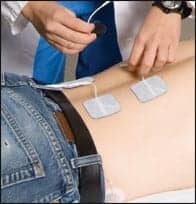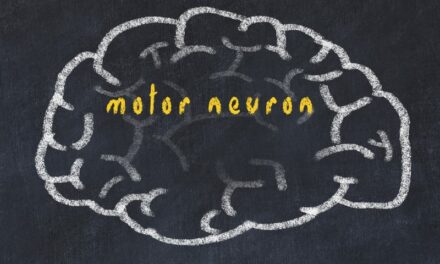 |
| Above, the ultimate portable pain care unit, iontophoresis patches are applied directly to the affected area. Medication is time released. |
When it comes to administering corticosteroids to reduce inflammation, iontophoresis has long offered a popular alternative to injections for physical therapy patients. The modality employs a direct current to transfer medications such as dexamethasone through the skin to the affected area.
Jason B. Han, PT, DPT, CSCS, has seen the positive effects of this treatment modality from both sides of the table. When he sprained his acromioclavicular joint a couple of years ago, his athletic trainers applied iontophoresis directly to the spot to alleviate the pain.
“I had a pretty bad sprain, and that seemed to help,” Han says.
Today, the sports resident at the University of Pittsburgh Medical Center (UPMC) Center for Sports Medicine uses the modality to treat his own patients, particularly those with plantar fasciitis or lateral epicondylitis.
“It seems to work really well with areas of the body that are very close to the skin,” Han says.
In these cases, iontophoresis can be an effective alternative to injections or oral medications. Because iontophoresis is applied directly, it minimizes the amount of medication that enters the bloodstream.
“I think it’s a lot safer, and it’s a lot more specific,” Han says. “If you have lateral epicondylitis, instead of taking an anti-inflammatory such as ibuprofen—which is very general to your body—you can apply a specific modality directly to that exact area.”
It is also an attractive option for patients who shy away from needles. “I think most people would prefer the iontophoresis to a needle going in their skin,” Han says.
A GOOD OPTION
For the most part, patients think favorably of the treatment, according to Julie K. Silver, MD, assistant professor in the Department of Physical Medicine and Rehabilitation at Harvard Medical School, Boston, and coauthor of Easy Injections (Butterworth-Heinemann, 2007). Silver often prescribes iontophoresis for joint pain, tendonitis, and osteoarthritis, as well as epicondylitis.
“Patients are positive about it when it works—and it often does, in my experience,” she says.
Of course, some iontophoresis patients experience a little discomfort—irritation and redness of the skin are not uncommon. Han compares the sensation of the treatment to feeling “pins and needles.”
“It feels kind of like electrical stimulation, but it’s very localized because it’s only under that one pad,” he says. “That’s why some people might feel like it’s uncomfortable. But like anything else, you get used to it over time.”
Han usually tries iontophoresis two or three times before deciding whether the treatment is effective. Because iontophoresis is nearly always used in conjunction with other treatment modalities for pain management, he notes that it can be difficult to determine which modality is responsible for improvement in a patient.
“There are a lot of factors that come into play,” he says. “Are they getting better because of iontophoresis, or are they getting better because of their exercises or their stretching?”
While the effectiveness of iontophoresis is well known to physical therapists, some physicians are still in the dark about this modality. “What I find is a lot of the physicians that I work with, particularly primary care doctors, have never used it and don’t really know how to prescribe it,” Silver says. “They’re happy and surprised when they hear about it and hear that it works.”
This gives physical therapists the opportunity to educate their referring physicians on this topic. “I think if a patient isn’t progressing, it’s a good thing to talk to the physician about iontophoresis,” Silver says. “The physical therapists actually know much more about it. So, it’s a good modality to talk to the doctor about considering.”
IN PRACTICE
Iontophoresis is often administered in a clinical setting. To perform the treatment, physical therapists traditionally use a portable unit in the clinic to apply two electrode pads—one medicated pad, and one dispersive pad—to the affected area. Recently, Han has been using iontophoresis to treat a patient with flexor hallucis tendonitis—a common condition among dancers.
“They actually have to use their toe flexors a lot more,” Han says. “And that makes them a little more prone to irritation of that first toe flexor.”
Some clinics fill prescriptions for iontophoresis medications in house; others, such as the UPMC Center for Sports Medicine, require patients to bring their own. As a result, Han’s patient provides her own dexamethasone for each session.
“We use our own pads,” Han says. “I take the medication from her and dispense it onto the pad, and I give her back the vial of medication to take with her.”
Treatment lengths and times vary—the general rule of thumb is to stay between 40 and 80 mA per minute.
“It really depends on how high you’re turning up their frequency,” Han says. “Let’s say I want to treat them with 40 mA per minute. I usually run the electricity gauge between 1 and 4 mA. If they can tolerate 4 mA, then I only have to leave it on for 10 minutes. If 2 mA is the highest they can tolerate that little electrical feeling, then I leave it on for 20 minutes.”
ON THE GO
Until relatively recently, iontophoresis required patients to receive treatment from a portable unit—usually housed in a physical therapy clinic—for upward of 20 minutes a session. But today, wearable patches offer patients treatment on the go.
“I’ve actually used those myself, and I love them,” Silver says. “They’re great. You just put them on and wear them around, and when you take them off, it feels better.”
Both Silver and Han have found these patches to be successful with their patients. “It sticks pretty well,” Han says. “It actually forms to their body, and then it doesn’t really get in their way.”
Han uses the a patch, which is designed to deliver an 80 mA per minute dosage in 3 hours. The physical therapist fills the patch with the prescribed medication, applies the patch to the affected area on the patient, then pulls a tab to activate the treatment. An indicator light on the patch shows that treatment is in progress. When treatment finishes, the patient disposes of the pad.
“It’s really easy to use,” Han says. He adds that when using traditional units, physical therapists must spend time placing the wires on the patient—a step that is eliminated with the wire-free patches.
In Han’s experience, using the patch also reduces the skin irritation associated with iontophoresis. He attributes this to the fact that the patch takes longer to deliver the medication. “I feel it’s a little bit safer to dispense it over time versus really trying to drive it in within 20 minutes or so,” he says. “The patient response is they don’t experience as much discomfort or skin irritation. It just seems to work a little better.”
NOT FOR EVERYONE
No matter which modality a clinic uses, it is important to educate patients about the effectiveness of iontophoresis when discussing their treatment options.
“I tell my patients that it’s another way of delivering medication and that sometimes it works really well and sometimes it doesn’t,” Silver says. “It’s generally safe and easy to use. So, it’s typically worth trying as long as there’s no contraindication.”
The most common contraindication is an allergy to the medication itself. Because dexamethasone is used most often with iontophoresis, those who are allergic to sulfa are not candidates for the treatment.
Some specific conditions cannot be treated with iontophoresis. The treatment is contraindicated for pregnant women, patients who have pacemakers, and those with open wounds. The procedure cannot be applied over metal—so any patient with metal in the affected area of the body is not a candidate.
In patients with dark skin, there is also a risk of lightening of the skin in the affected area. “That’s true with any corticosteroid, including injections,” Silver says. “You can have some depigmentation.”
Physical therapists should also be cautious about applying iontophoresis on cancer patients. “It’s not really clear which modalities are safe to use in cancer patients, and which ones aren’t,” Silver says. “Probably a good rule of thumb is to avoid modalities over tumors. Beyond that, clinical judgment is what most physicians use.”
In some cases, iontophoresis may be effective for a patient with cancer who has not been responding to physical therapy. For example, there could be complications with injection for a woman who has undergone a mastectomy and has a rotator cuff impingement with an element of tendonitis and inflammation.
“If you don’t want to inject because of the risk of lymphedema, then you could consider iontophoresis,” Silver says. In these cases, she adds that iontophoresis could improve a patient’s quality of life.
Whether using the traditional iontophoresis unit or the patches, it is important to educate patients about contraindications. “The main thing with these patients is that they monitor their skin symptoms,” Han says. “If they feel any burning or really excessive discomfort, that’s when you would probably take it off because you don’t want to do any more damage.”
After removing the patches, a little redness is normal—but it should disappear within 24 hours. “If the redness stays there for a lot longer than it should or your symptoms start to get worse, that’s when you contact the physical therapist or the physician,” Han says.
COST OF CARE
Reimbursement is generally not a problem for iontophoresis orders, but the profit margins are fairly low for the UPMC Center for Sports Medicine. “If you take into consideration the cost of the pads versus how much we get reimbursed, I think we only make a few dollars—maybe $5 or $10,” Han says.
Han notes that reimbursement rates could improve as researchers begin to compile more clinical results about the effectiveness of iontophoresis for specific conditions. In the meantime, the clinic continues to provide iontophoresis as an option for its patients.
“We’re doing what we can to make patients better,” Han says. “If we lose a few dollars or make a few dollars on iontophoresis, but we’re using it in conjunction with our therapeutic exercise and our manual treatment, then it really doesn’t matter because we’re making the patient better.”
Ann H. Carlson is a contributing writer for Rehab Management. For further information, contact .




